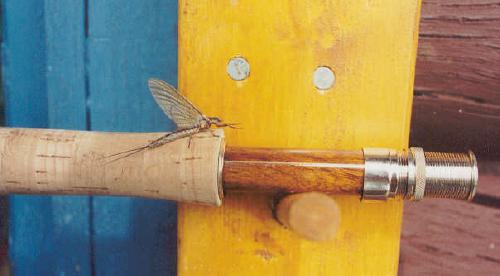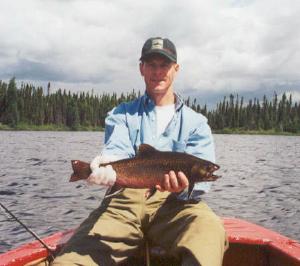Fly Fishing for Brook Trout in Labrador

The Green Drake of Labrador
Ups: Friendly people at the camp--Great hatches—Good guides—Big brook trout—Great food
Downs: Black flies—Weather (bring a raincoat)—Airline flights
Contact: Cooper’s Minipi Camps, P.O. Box 340, Stn B, Goose Bay, Labrador NF, Canada A0P 1E0;709-896-2891.www.minipicamps.com
There are two places that I’ve wanted to fly fish before I die—New Zealand and Labrador. New Zealand—been there—done that. I had my introduction to Labrador in July and August 2001. For several years I had heard great stories of the huge brook trout from Steve McDonald. Steve’s an anesthesiologist from the Doylestown area of Pennsylvania. Give him a fly rod and he becomes Steve McDonald, avid fly fisher.
Steve and I traveled to Cooper’s Minipi Camps just south of Goose Bay, Labrador, to find out just how good the brook trout fishing there was. What a spectacular way to introduce me to fly fishing in Labrador. That float plane landed within a hundred feet of the lodge on Anne Marie Lake. For the next week Steve, me and seven other anglers would call Anne Marie lodge home.
The first night we arrived the giant Green Drake hatch of the north (Hexagenia rigida) made its appearance. We could look forward to a week of matching hatches to rising 4 to 8 pound brook trout. That first evening thousands—no millions--of huge yellow mayflies popped onto the surface. A size 6 or 8 long shank hook with a body of pale yellow and olive wings would match the hatch adequately. Ralph Coles, our guide for the evening, directed the canoe towards a section of the Minipi River system locals call "Loverboy."
The Minipi River system is an unusual area. You’ll see lakes and ponds with rivers flowing in and out of them. The faster sections might be only a few hundred feet long. Many of the bigger brook trout live in the lakes and some of the smaller fish in the faster sections. Northern pike also coexist with the brook trout in these lakes and ponds.
That first evening we fished it seemed like every Green Drake in Canada decided to appear on the waters. Millions and millions decided to appear on the surface that evening and the extremely cool late July evening prevented all but a few of the hardiest from taking flight. About 8:30 P.M. our guide drifted the canoe into a small cove. That area was lined with lily pads and three heavy risers sipped in a dun or two and then moved on. Minipi brook trout sip in a dun and then move to another location 15 to 30 feet away from the first rise. I think they constantly move because of conditioning brought on by predators like the osprey and the northern pike. Which way the trout headed for their next morsel was extremely difficult to predict. Finally a trout boiled at Steve’s pattern and he fought a 4 ¾ pound Minipi-bred brook trout. Duns emerged and trout fed for more than two hours that first evening.

Steve McDonald holds a nice Labrador Brook Trout
That first evening proved to be a harbinger of things to come—great hatches and heavy rising trout for the next week. The same hatch continued to appear for the entire week and every evening we landed some heavy trout on dry flies. Steve McDonald landed one of the biggest fish of the week—an eight-pound brook trout that took a different version of a Yellow Stimulator called the Laid Back Hex. (John Clarke, one of the other anglers at the lodge, landed one 8 ¼ pounds the very next evening.) That Stimulator type pattern worked especially well when we saw trout chasing emergers. The two of us caught 10 trout over 4 ¾ pounds on that Stimulator type pattern. I’m convinced that the down wings suggest an emerging dun to the trout.
On several evenings trout fed towards dark on spent Green Drake spinners. When they fed on these dead mayflies they didn’t move as far for their next rise. Maybe it was because it was darker or that the spinners were more concentrated—but their movements were much more predictable.
You knew it was coming, didn’t you: How would these trout react to an attractor pattern like the Patriot dry fly? I tied up a half dozen of these attractor type patterns in size 10 so I could test this pattern in an unusual setting. One afternoon, when the action slowed considerably, I tied on a Patriot. As soon as I had secured the fly with a clinch knot a trout rose 30 feet from the boat. I cast the fly in the direction I thought the trout would move and I saw a hug gulp at the red, white and blue pattern. I set the hook and the trout headed deep—into a weed bed and broke me off. I now had only five Patriots left for the entire week. Ten more trout hit that pattern that afternoon. Before we headed back to camp in late afternoon I was down to one Patriot. Did the Patriot work? You bet it did!
What great matching the hatch opportunities—especially at night! What heavy native brook trout. I had never seen trout like these before in the 50 years I fly fished. The one-week trip to Cooper’s Minipi Camp turned out to be much more than I had anticipated. It’s a once in a lifetime experience. But it was more than just great fly fishing over huge trout for a week. The whole experience was a happening—it was meeting new friends. Staying at the camp with Steve and me were Dave and John A. Fillmore, Tom Rogers, Henry Taylor, John Clarke, Ed Quigley and George Boder. Henry from Green Vallley, Arizona, and Tom Rogers from Brule, Wisconsin, traveled to the camp to complete a video they’ve been working on for several years. Dave, John A. and John Clarke were Canadians and some of the finest fly fishers I have ever encountered. We all became friends after a week of sharing fly fishing experiences on the Minipi River.
Dave Fillmore taught me several lessons when fishing for brook trout at the Minipi Camps. Afternoon fishing was usually slow—few mayflies emerging and few trout rising. Dave and his guide used the afternoon hours to decide where they’d spend the productive evening hours. They’d look for feeding fish, for insects appearing and then decide on a strategy for the evening.
You can’t lie about the number of trout you catch at Cooper’s Minipi Camp. Guides Raymond Best, Patrick Broomfield, Howard Guptill, Chad Snow and Ralph Coles keep a record of every trout over three pounds caught. They even tag some of the fish so they know their movement. For the week the group caught 131 trout over three pounds. If you ever get the chance to fly fish for brook trout in Labrador do it! You’ll enjoy the experience of a lifetime.
Read more about this hatch and many, many more in a new book entitled The Hatches Made Simple.. It will be on the market in March 2002. This new book will truly be an innovative, revolutionary book on the hatches. To insure that you get a First Edition of this important new work call 1-802-457-4826.
|